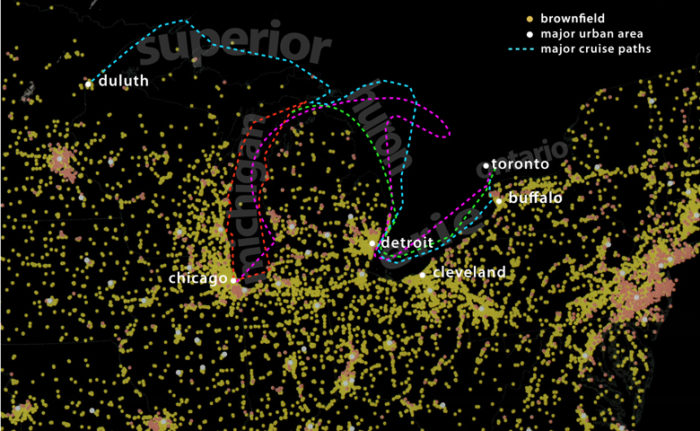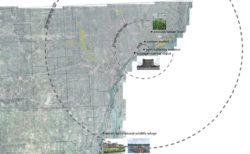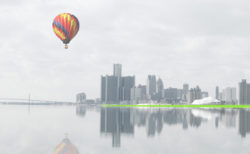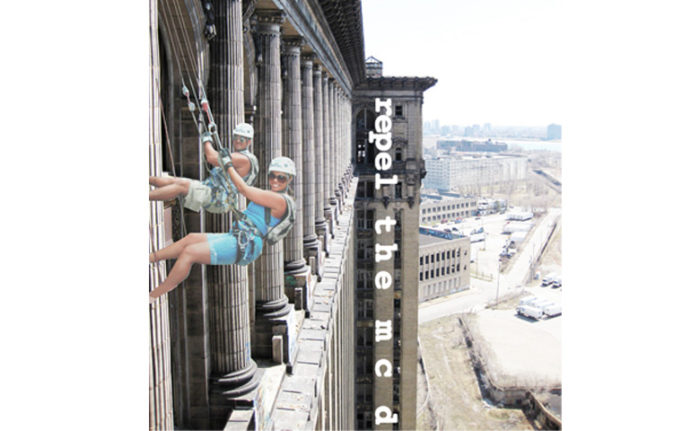DETROIT PORT AUTHORITY – PART 2 – THE ECO-INDUSTRIAL CRUISE LINE
 The Eco-Industrial Cruise Line – Hybrid Sustainability. Just as urban design cannot be thought of simply as architecture on a larger scale, sustainable urbanism is not merely a collection of ‘green’ buildings, spaces, and infrastructure upgrades. The transformation of America’s former industrial capitals from beleaguered shrinking cities into thriving urban centers depends not only on an agglomeration of high tech interventions – such as solar and wind farms, green roofs, electric cars, etc – but on a radical paradigm shift in the nature of land use, density, transportation and the role of our industrial heritage on future policy.
The Eco-Industrial Cruise Line – Hybrid Sustainability. Just as urban design cannot be thought of simply as architecture on a larger scale, sustainable urbanism is not merely a collection of ‘green’ buildings, spaces, and infrastructure upgrades. The transformation of America’s former industrial capitals from beleaguered shrinking cities into thriving urban centers depends not only on an agglomeration of high tech interventions – such as solar and wind farms, green roofs, electric cars, etc – but on a radical paradigm shift in the nature of land use, density, transportation and the role of our industrial heritage on future policy.
This blog post outlines such a paradigm shift, narrating the proposed evolution of Detroit’s post-industrial region through the introduction of Eco-Industrial Tourism via an Eco-Industrial Cruise Line.
Post industrial vacancy as multi-scalar void. In densely populated cities such as New York City, Boston, and Chicago, brownfield sites are reclaimed and stitched back into the urban fabric, ultimately utilized by their host city. In post industrial cities such as Detroit, however, the city has retreated, no longer including these abandoned outposts. Combine all of these individual outposts together, and the metropolitan region is scarred by large swaths of contaminated land, compartmentalizing dissipated downtowns from their thriving suburban counterparts. Analyzed at a national scale, post industrial zones stretch from Detroit to Cleveland to Buffalo. All share the same debilitating characteristics: shrinking cities, suffering economies, and distorted reputations.
Post industrial vacancy as amenity. The vacancy within these multi-scalar, post industrial networks carry a profoundly negative stigma, a constant reminder of past glory and present day stagnation. Yet, if properly re-programmed and re-designed, these vacant space networks can act as a catalyst within a multiplicity of scales and thereby result in a new social paradigm.
Post industrial vacancy as Eco-Industrial Tourism. These post industrial sites and corridors should be utilized as infrastructure. This simple thesis is the platform for our social paradigm shift and sets the stage for the introduction of a radical hybrid program, “Eco-Industrial Tourism”. Eco-Industrial Tourism takes pride in the post industrial landscape, re-introduces natural ecosystems, and fills the void of a vacant cultural identity. In many cases, nature has already reintroduced itself to Detroit’s post-industrial ruins. Vegetation has reclaimed the Packard Plant, Michigan Central Depot, abandoned freight lines, book depositories, and once thriving public schools. In HAA’s August lecture, Sweet-Juniper! questioned Detroit’s ownership of their post-industrial ruins. Similar to Roman tourism, visitors flock to see Detroit ruins, why not create a park accentuating these relics? Jim Griffioen further described utilizing these empty Detroit monuments through paid, guided urban exploration. In summary, Sweet Juniper! proposes that if Rome can accept the fall of their empire, appreciate the wreckage resulting from a transference of power, and then market their architectural remains…perhaps Detroit can follow suit.
However, it is not enough to keep these ‘ruins’ submissive, a mere camera backdrop or documentary setting. Eco-Industrial Tourism does not celebrate the loss of what was once Detroit, rather its conception is more about a continuum from one state to another, a celebration of Detroit in flux. Furthermore, Eco-Industrial Tourism capitalizes on an already existing underground tourism and then takes it one step further by legitimizing the industry with performative programming, turning the tourist’s experience from passive to active.
Why not insert climbing walls and rappelling systems into the Michigan Central Depot? Similar to Germany’s Landschaftspark, one could climb through any of our cavernous structures, a bed of urban agriculture two stories below their dangling feet. Why not insert a park, complete with a educational sustainability museum, into a former 44 acre paint factory such as HAA’s Detroit River International Wildlife Refuge Project? In Chicago, tourists ride segways through pristine lakefront parks. Detroit can offer a different experience: spelunking through underground caverns, planting a tree in the latest urban farm, composting with soup kitchens, bird watching in the shadows of the Renaissance center, biking graffiti lined passageways of a re-purposed, abandoned railway.
With the correct identification, strategic programming, and marketing of specific post-industrial structures, Detroit can take ownership of these unique conditions and put many of these highly regarded, abandoned structures to use.
Eco-Industrial Cruise Lines. Collage multiple re-programmed structures together with a unique narrative, and Detroit becomes the poster child for a new industry, Eco-Industrial Tourism. But Detroit is not unique in its post-industrial state; many other rust-belt cities offer the same Eco-Industrial Tourism opportunities. By re-purposing our most valuable infrastructure, The Great Lakes, we can creatively re-purpose an entire region.
A Michigan consortium called the “Port Cities Collaborative” is a group of 23 port towns working to market themselves to Great Lakes Cruise Lines. This consortium has identified a strong connection between the usage of cruise wharfs and the development of cruise programs; programs that allow cruise participants to experience a city’s unique culture on land.
Recognizing the potential influence of the cruise industry upon Detroit, the Detroit / Wayne County Port Authority has commissioned Hamilton Anderson Associates (HAA) to design a new 22,000 square foot international ship passenger terminal. Currently under construction in Detroit, The Port Authority Terminal is designed to function as both a domestic and international facility, including associated functions such as customs, border patrol, baggage handling, ticketing, and queuing. The building and dock will accommodate Great Lakes cruise ships, tall ships, and other large vessels, as well as the offices for the Port Authority. The Port Authority anticipates this terminal will serve as a port of call for the many cruise vessels that sail the Great Lakes each summer, some providing accommodations for over 400 passengers. These cruise lines will ideally make Detroit one of their premier urban ports, bringing tourists and their dollars directly into downtown Detroit.
In a more traditional cruise, Detroit can offer a unique eco-industrial counterpoint to other ports of more rural locales. Conversely, thematic cruises can bundle multiple post-industrial cities, providing 4 – 7 day cruises focusing on these eco-industrial sites. Detroit is not unique in these post-industrial conditions. Detroit, Cleveland, and Buffalo all share the same overabundance of dilapidated structures, contaminated fields, and Great Lakes access. Working with such groups as GLUE (Great Lakes Urban Exchange) would offer valuable networking between rustbelt cities, and thereby strengthen a potential regional destination program.
Similar to the repurposing of post-industrial structures, the Detroit Metropolitan Region (and the rustbelt) needs to be creatively re-purposed. In all moments of the Eco-Industrial cruise – from disembarking to programmed day trips to meals to overland travel – new tourists must have an opportunity to personally engage in their new context. Each visitor must be given an opportunity to recognize the obvious disconnect between the media’s portrayal of Detroit and the Detroit they are personally experiencing. This moment of understanding will reinforce a local, regional, and national re-branding of Detroit. As residents, we must take ownership of Detroit’s (and Detroit Metro Region’s) reputation and identity; Eco-Industrial Tourism acknowledges our past and marks a threshold towards the future.
With that in mind, we have laid out an example of a viable Detroit itinerary:
Eco-Industrial Tour
Detroit Itinerary – Day 1
Entry through Port Authority Terminal
Bike Tour:
Eastern Market Tour:
– Tour of Detroit Urban Agriculture
– Tour of Detroit Public School Agriculture Outreach Programs
Lunch at Eastern Market
– Strolling lunch through local restaurants supportive of local urban agriculture
Bio-diesel bus ride to tour the following:
– Detroit River International Wildlife Refuge
Overnight accommodations at Detroit’s premiere Sustainable Hotel
Detroit Itinerary – Day 2
Bio-diesel bus ride to tour the following:
– Packard Plant Beekeeping Tour
Lunch at Detroit’s premiere Sustainable Restaurant
Bio-diesel bus ride to tour the following:
– Greening of Detroit’s Nursery
– Belle Isle’s Urban Bird Sanctuary
Exit through Port Authority Terminal
Day 3 – Cleveland
Day 4 – Cleveland
Day 5 – Buffalo
Day 6 – Buffalo
Day 7 – Detroit







